How To Access Shared Folder In Windows Xp
Solusi
For the settings before using the Scan to File Server function (SMB) (related information), setting the IP address (related information), setting upwardly a shared folder, and setting the machine for the Browse to File Server function are required.
This section describes how to setup a shared folder later the IP address is set.
There are two setting options for the shared folder.
- Shared Binder without Admission Control
- Shared Folder with Access Command
NOTE
If "Access permissions" are granted to users who are registered for computers, they are authorized to operate folders and files.
This section describes the procedure for granting FULL Command permission to the "Everyone" business relationship then that any user tin can admission the shared folder.
There are ii types of access permissions:
- Network-level admission permission
This is to control users who access to the shared folder over the network.
- Local-level access permission
This is to command users who access folders by logging on to their computers.
The local-level access permission can be ready only when the bulldoze in which folders are located is formatted in NTFS.
Shared Folder without Access Command
This is useful when you lot want to share files with other users over a network without whatever restrictions.
Users can access these folders from whatever reckoner on the network without having to enter a user name and password.
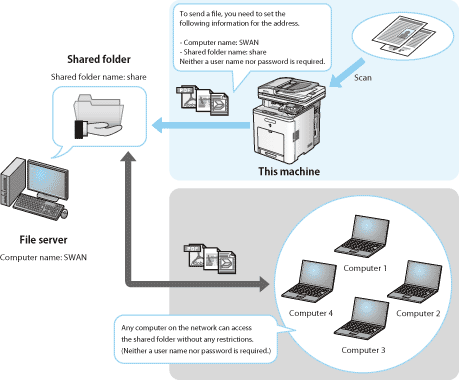
Follow the procedure below to set up the shared folder without access control.
If you lot are using Windows XP Professional person or Windows XP Abode Edition, use elementary file sharing to set the shared folders without access control.
NOTE
If you are using Windows XP Professional and simple file sharing is disabled, follow the procedures beneath to enable information technology.
- On the [Start] menu, select [Command Panel], and so select [Folder Options] to open the [Folder Options] dialog box.
- Select the [View] tab.
- Under [Avant-garde settings], select the [Employ simple file sharing (Recommended)] cheque box.
- Click [OK] to close the [Binder Options] dialog box.
1. Create a new shared folder in whatever drive.
It is recommended to create the folder in a place where users tin can find it easily, such every bit the first level in C drive.
Ex.: C:\share
2. Correct-click the created folder.
iii. Select [Sharing and Security...] to open the [<Binder name> Properties] dialog box.
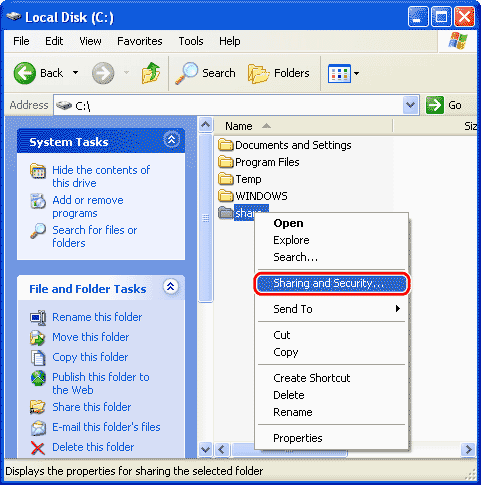
4. Click [If you understand the security risks simply want to share files without running the wizard, click here.].
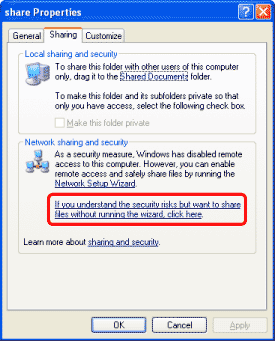
Notation
This bulletin is only displayed the kickoff time you open up the dialog box. If y'all are opening the dialog box for the second or subsequent fourth dimension, proceed to Pace vi.
five. In the [Enable File Sharing] dialog box, select the [But enable file sharing] check box, so click [OK].
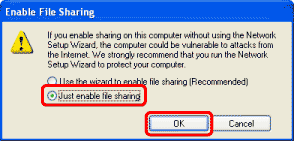
6. Select the [Share this folder on the network] and [Allow network users to change my files] check boxes.

vii. Click [OK] to close the [<Folder name> Properties] dialog box.
Shared Binder with Access Control
This is useful when you desire to limit admission to certain users.
To admission a shared binder of this type, users accept account information (user names and passwords) for the shared folder. If they practice not know their business relationship information, they cannot access that shard folder.

Follow the procedure below to admission a shared binder with admission control.
 Creating a User Business relationship for Accessing a Shared Binder
Creating a User Business relationship for Accessing a Shared Binder
Y'all need to create user accounts for users who access the shared folder in advance. This section describes the process for creating a new account on your computer.
NOTE
Even if y'all do non create a new account by post-obit the procedures below, you tin add together a pre-registered account for users who are permitted to access the shared folder. In such case, you need to create a password if one has non been set for the preregistered account. Once the password is created, the user is prompted to blazon the password when logging on to a reckoner.
1. On the [start] carte du jour, select [Control Panel] to open [Control Console].
2. Click [User Accounts].
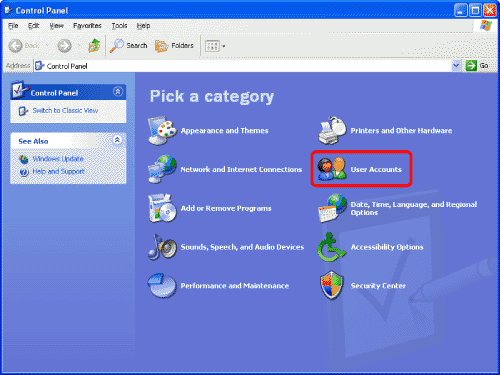
3. In the [User Accounts] dialog box, click [Create a new business relationship].
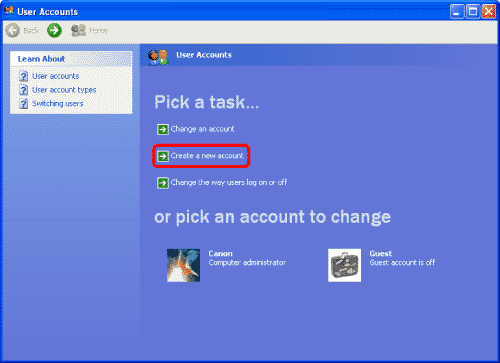
4. Type a user name in [Type a name for the new business relationship], then click [Next>].
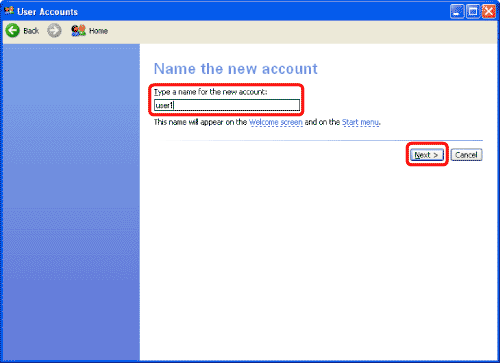
Notation
The user proper noun must be upwards to 20 alphanumeric characters long.
5. Select [Limited], and and then click [Create Account].
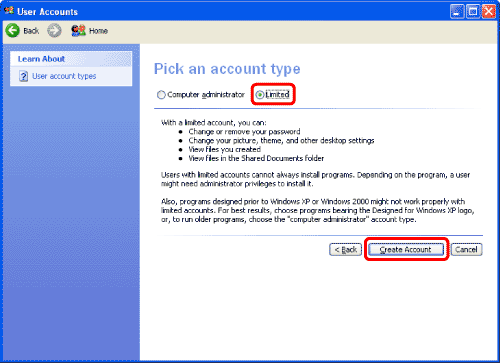
6. Click the created user, and and so click [Create a password].

seven. Type a password in [Type a new password] and [Blazon the new password again to confirm], and then click [Create Password].

NOTE
The password must be up to 14 alphanumeric characters long.
8. Close the [User Accounts] dialog box.
 Setting a Shared Folder and Admission Permissions
Setting a Shared Folder and Admission Permissions
Once you create the account on your reckoner, create a shared folder. Add the created account to the shared folder equally a user who is permitted to access that folder. Set access permissions and so that the user tin that binder every bit well.
- Create a new shared binder in whatever drive.
It is recommended to create the folder in a identify where users can find it easily, such as the starting time level in C drive.
Ex.: C:\share
- Correct-click the created folder.
- Select [Sharing and Security...] to open the [<Folder name> Properties] dialog box.
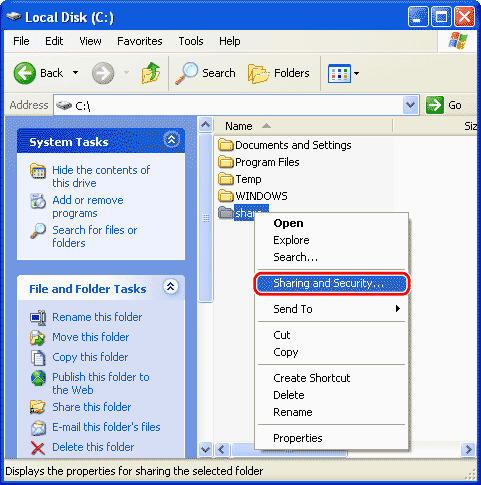
- Select [Share this folder].
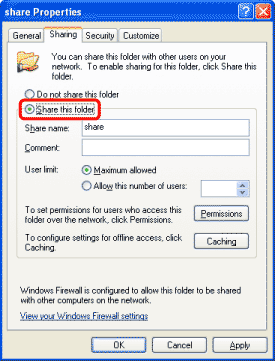
2. Set the network-level admission permission.
- In the [Sharing] canvas, click the [Permissions] push button to open the [Permissions for <Folder Name>].
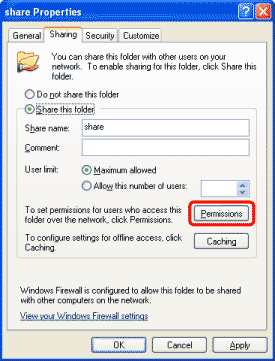
- Click [Add...] to open the [Select Users or Groups] dialog box.
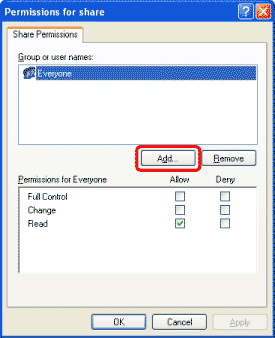
- Type [Figurer Name]\[User Proper noun] in [Enter the object names to select].
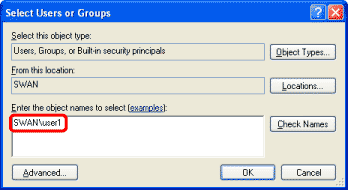
- Click [Check Names]. Make sure that the correct object name is typed.
Notation
The [Name Not Found] dialog box appears if you enter an incorrect object name. If this happens, click [Cancel] to close the dialog box and bank check the computer name and user name.
- Click [OK] to shut the [Select Users or Groups] dialog box.
- In the [Permissions for <Folder name>], under [Group or user names], select the user whom you desire to grant permission. Select the [Full Control] box under [Permit].

NOTE
Select the [Full Control] box and then that you lot can store information scanned with this machine on a computer (the file server).
- Click [OK] to close the [Permissions for <Folder Proper name>] dialog box.
- If the [Security] tab is displayed in the [<Folder name> Properties], keep to Step iii to set up the local-level access permission. If not, proceed to Pace 4.
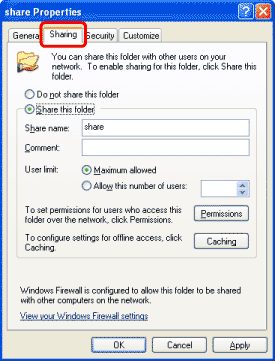
NOTE
The [Security] tab is not displayed when:
- The drive to which the shared binder is set is formatted in FAT16 or FAT32.
- Uncomplicated file sharing is enabled.
3. Set the local-level admission permission.
If the drive to which the shared folder is fix is formatted in NTFS, you need to fix the local-level also as the network-level access permissions.
- In the [<Folder proper name> Backdrop], click the [Security] tab.
- Click [Add...] to open the [Select Users or Groups] dialog box.
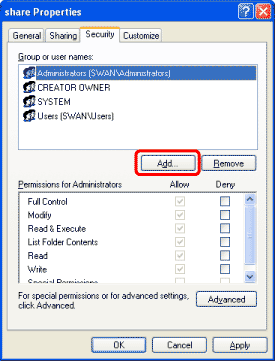
- Type [Computer Name]\[User Name] in [Enter the object names to select].

- Click [Check Names]. Make sure that the correct object name is typed.
NOTE
The [Name Not Establish] dialog box appears if you enter an incorrect object name. If this happens, click [Cancel] to close the dialog box and check the computer name and user name.
- Click [OK] to close the [Select Users or Groups] dialog box.
- In the [Security], nether [Group or user names], select the user whom you want to grant permission. Select the [Full Control] box under [Let].
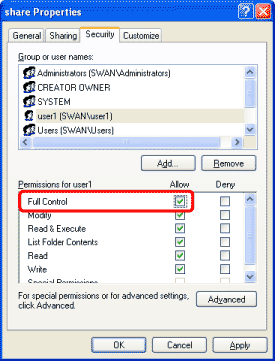
Note
Select the [Full Control] box so that you can store data scanned with this auto on a computer (the file server).
4. Click [OK] to close the [<Binder name> Properties] dialog box.
Source: https://id.canon/id/support/8200290900
Posted by: gloverweld1948.blogspot.com

0 Response to "How To Access Shared Folder In Windows Xp"
Post a Comment